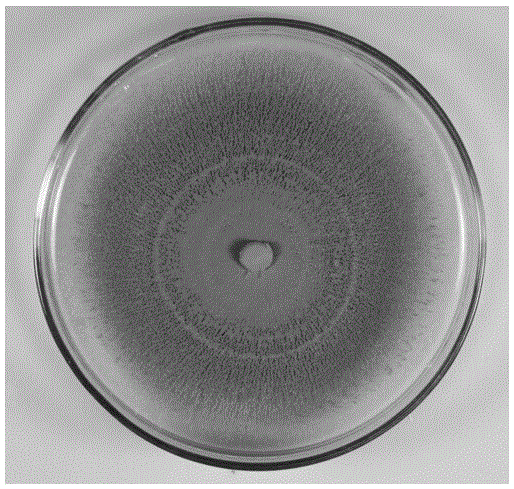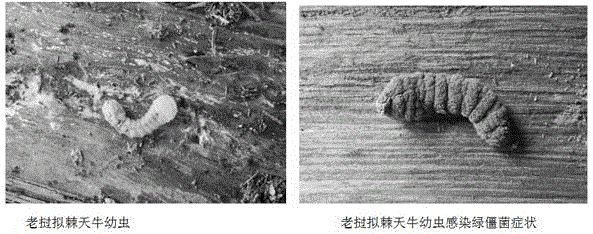Metarhizium strain pathogenic to Laos false blister beetles and application of metarhizium strain
A technology of pseudoecanthus and Metarhizium anisopliae, applied in application, fungi, pesticides, etc., can solve problems such as difference in pathogenicity of target pests, and achieve the reduction of larval population, strong pathogenicity, and sporulation. powerful effect
- Summary
- Abstract
- Description
- Claims
- Application Information
AI Technical Summary
Problems solved by technology
Method used
Image
Examples
Embodiment 1
[0030] Metarhizium anisopliae ( Metarhizium anisopliae ) Morphology of FJMa200902
[0031] Inoculate the isolated and purified Metarhizium anisopliae strains on a flat PPDA medium with a diameter of 90 mm and inoculate them at 25±1°C. After 4-5 days, pick hyphae and observe the growth of the strains under a microscope. Morphology of hyphae and conidiophores; 10-12 days later, pick mature conidia and make slices to observe the shape and size of conidia. Observe and record the morphological characteristics of the colony for about 15 days. The colony texture of this strain is cotton-wool, and the colony is white at the beginning, and gradually expands, and dark green conidia are produced on it, which are distributed in rings and rays. Mycelia branched, latticed, colorless and smooth, 2.3μm~3.2μm wide, conidiophores solitary or branched, with 2~5 columnar sporulation cells at the top of the branches, on which basal sporozoites are produced Conidia chain. Conidia are unicellul...
Embodiment 2
[0034] Metarhizium anisopliae ( Metarhizium anisopliae ) Biological properties of FJMa200902
[0035] Metarhizium anisopliae ( Metarhizium anisopliae ) FJMa200902 was inoculated in the center of the PPDA plate medium, cultured in an incubator at 25±1°C, and the colony diameter was measured once a day by the cross method, and 3 plates (repeated) were set up for each treatment, and observed for 15 days in total. At the same time, record the start time of sporulation. On the 15th day (sporulation is basically over), use a puncher with a diameter of 1.5cm to punch a small plate from the center of the colony to the edge 1 / 2, take out the plate and place it in a 0.3 ‰ Tween-80 sterile water in the Erlenmeyer flask, shake to fully disperse the spores and properly dilute, measure the concentration of spores with a hemocytometer and convert it into the amount of sporulation per unit area. Three bacterial discs were measured on each plate, and the average value was taken as the numb...
Embodiment 3
[0040] Metarhizium anisopliae ( Metarhizium anisopliae ) Determination of the pathogenicity of FJMa200902 to the larvae of the Laotian beetle
[0041]A certain amount of 0.03% Tween-80 solution was prepared, then sterilized at high temperature, and cooled for later use. Scrape a certain amount of Metarhizium anisopliae from the PPDA plate ( Metarhizium anisopliae ) FJMa200902 spores were placed in the above solution and prepared into 10 7 Spores / mL of spore suspension; immerse healthy Laotian beetle larvae in the spore suspension for 10 seconds, then put them back into the insect culture box and feed them with sterilized sawdust, and inoculate 30 Laotian beetle larvae , repeated 3 times; soaking 0.3‰ Tween-80 sterile aqueous solution as a blank control, and inoculating Metarhizium anisopliae MaZPTR-01 strain (a strain preserved by Fujian Academy of Forestry, a known strain) as a control, the inoculation method was the same as that of Concentrations are the same as above. ...
PUM
 Login to View More
Login to View More Abstract
Description
Claims
Application Information
 Login to View More
Login to View More - R&D
- Intellectual Property
- Life Sciences
- Materials
- Tech Scout
- Unparalleled Data Quality
- Higher Quality Content
- 60% Fewer Hallucinations
Browse by: Latest US Patents, China's latest patents, Technical Efficacy Thesaurus, Application Domain, Technology Topic, Popular Technical Reports.
© 2025 PatSnap. All rights reserved.Legal|Privacy policy|Modern Slavery Act Transparency Statement|Sitemap|About US| Contact US: help@patsnap.com



